Carrots are among the few popular vegetables and are very easy to grow. It contains many nutrients, including beta-carotene.
But because they are underground, it can be TRICKY for the new gardeners to know when to harvest carrot crops (and when to harvest carrot seeds). ISN’T that?
Well! AsterGardening has SPENT years researching and testing different plant and vegetable garden techniques. That allows us to provide you with the best gardening advice.
Our team of experts helps plenty of our readers to grow and harvest healthy crops. Now we are going to help you! COOL, right?
Today in this post, we go through when to harvest carrots for storing and immediate eating. Also, how can you harvest your entire crop of carrots?
So, without wasting a minute, LET’S BEGIN!
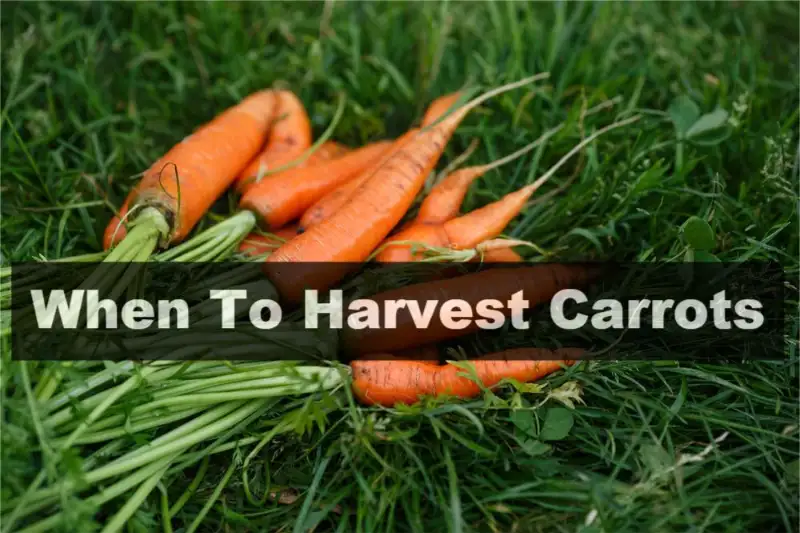
When to Harvest Carrots Based on Visual Signs?

Sometimes carrots are deceptive-they deceive you.
Actually, their leaves grow WITHOUT the proper development of carrots.
It makes you THINK that the underground carrot is equally grown as the leaves.
But when you go into depth to find the carrot, they are tiny.
It is INSANE. Isn’t it?
Well! One way to tell the time of the carrot harvest is by looking at your carrot’s TOP (shoulder).
If the green tops of most carrots begin to POP OUT of the ground, it’s the BEST time to harvest.
On the other hand, sometimes the carrot shoulders aren’t visible to you. In that case, dig carrots from one or two places and check their size and color.
Doing so lets you KNOW precisely what your carrots are actually doing.
When to Harvest Carrots for Storage?
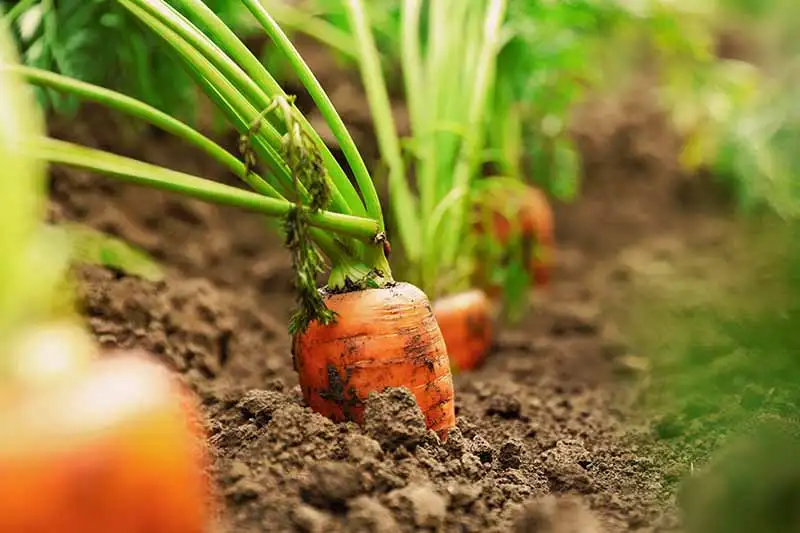
Carrots are root vegetables that have a long shelf life. It means it can be stored for several weeks or even months. ISN’T THAT AWESOME?
But some people still feel confused about storing carrots?
Carrots are generally READY to harvest for long-term storage when they are ripe. To tell if they are ripe, check if they are FULL-SIZED carrots and are FIRM to the touch.
- To store your carrots, gently BRUSH OFF the dirt from the surface of the carrots.
- Remember, do not wash the carrots, as moisture may cause them to spoil more quickly.
- Trim the green tops of the carrots, leaving an inch of the carrot top attached to the root.
- Store carrots in a COOL, DRY place. If the carrots are not stored in a cool space, they may become SOFT.
The Best Time to Harvesting Carrots for Immediate Eating
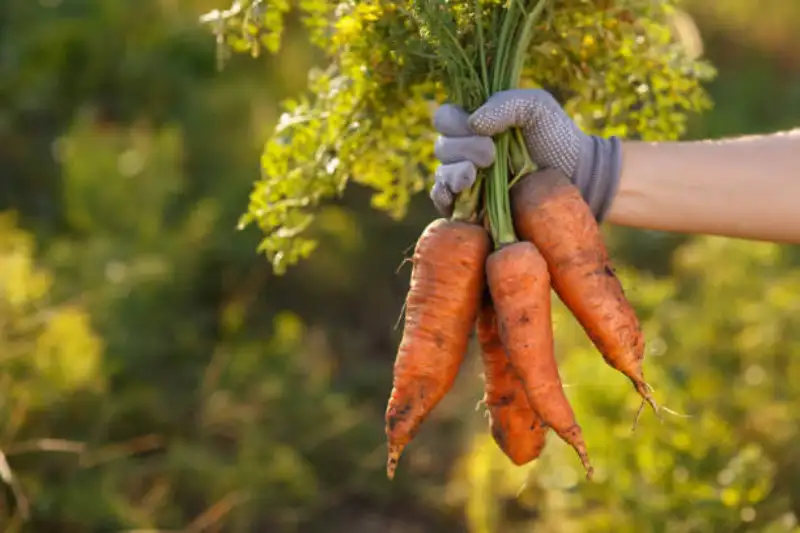
Carrots usually take 2-3 months to GROW and be ready to USE in recipes to make your own food, like soup or pasta.
Oh yes! Have you ever heard about gold soup?
You make it at home by putting twenty-four carrots in a simple soup.
Listen—The best time for the continuous harvest of fresh carrots for eating depends on the TYPE of carrot and the growing SEASON.
- To see if you have mature carrots enough to be harvested, gently pull one out of the ground and check its size and color.
- If the carrots are large and deep orange, it is likely ready to harvest.
- Use a garden tool such as a digging fork and gently lift the carrots out of the ground.
- Once the carrots are harvested, you need to enjoy the taste of fresh carrots.
How to Know When Carrots are Ready to Pick?
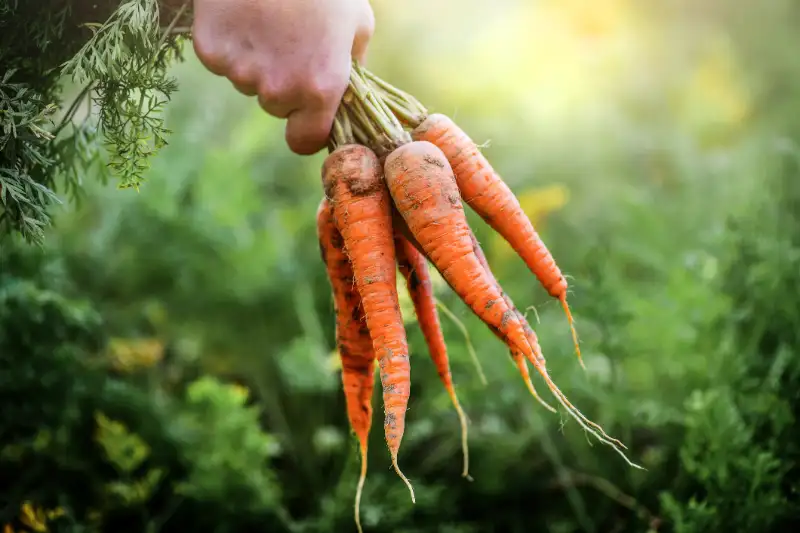
There are some SIGNS you need to look for to determine when you can PICK carrots:
Size
Carrots are able to harvest when they reach their FULL size.
Different carrot VARIETIES grow in various sizes. Some are naturally smaller, while others are naturally larger.
If you don’t know the average SIZE of the growing carrots, compare the size of the one with the others of the same batch.
If the carrot is large and deep orange, it is likely ready for harvest.
Color
Mostly, carrots get READY to harvest when they have a bright orange color.
If the carrots are pale yellow, they still are baby carrots (not fully matured). Thus, they need to get some more BENEFITS from the ground.
Firmness
Harvest time of carrots reaches when they are FIRM to touch, not soft and soggy.
If the carrots are soft, they are baby carrots and are not fully matured.
They need to STAY in the ground for some additional time.
How to Harvest Carrots Successfully?
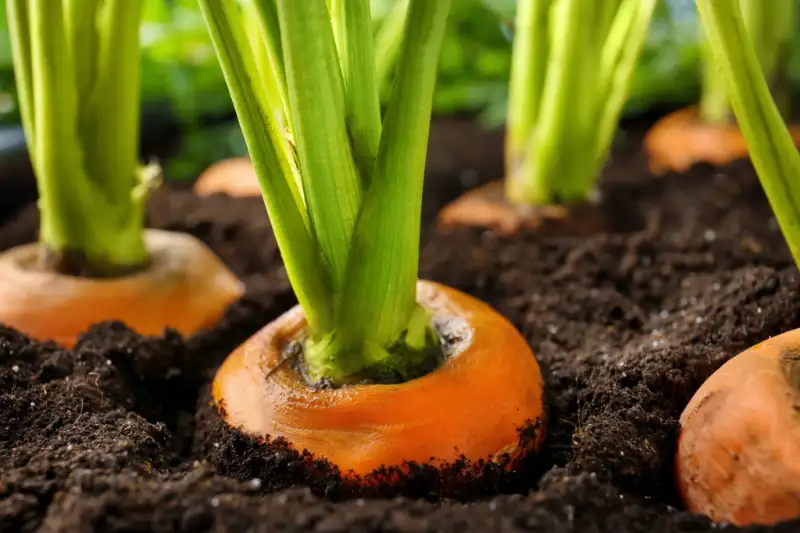
To harvest carrots successfully, you need to follow a few steps.
Determine when the carrots are ready to harvest
Do you still need clarification about when your carrots will be ready for harvest?
Hope you are not.
Well! carrots are typically ready to harvest when they reach their FULL SIZE and are FIRM to the touch.
For this purpose, you NEED to gently lift a carrot out of the ground and check its size and color.
AGAIN! If your carrot is small and pale in color, it is not fully mature, and vice versa.
Usage of the right tools
To harvest the carrots, use a garden fork to lift them out of the ground GENTLY.
Make sure to use a sharp enough tool to easily loosen the soil without damaging the carrots.
Suggested reading: Best Beginner Gardening Kit
Handle the carrots gently
Carrot roots are delicate that can be EASILY bruised if handled roughly.
So, after a harvest, handle the carrots gently to AVOID damaging them.
GET THIS?
Blemishes
Make sure that ALL the carrots must be FREE of blemishes and damage, such as cracks or splits.
If the carrots are damaged, they may not be suitable forSTORAGE.
Remove Dirt
Once you harvest the carrots without any blemishes, gently brush off the EXCESS dirt.
Please do not wash the carrots, as excess moisture may cause them to spoil more rapidly.
Cut off the tops.
Trim the carrot tops, leaving about an INCH of the carrot greens. The green growth should be lavish and not yellowing or wilting.
Storage
Carrots store well at low temperatures. Nearly at around 32F with high relative humidity. Pack your carrots in moist sand, and store them in a root cellar or basement.
If the carrots are not stored in a cool location, they wilt.
The best and easy way to store the carrots is to put them in the fridge in a plastic bag.
Tips for Harvesting Carrots
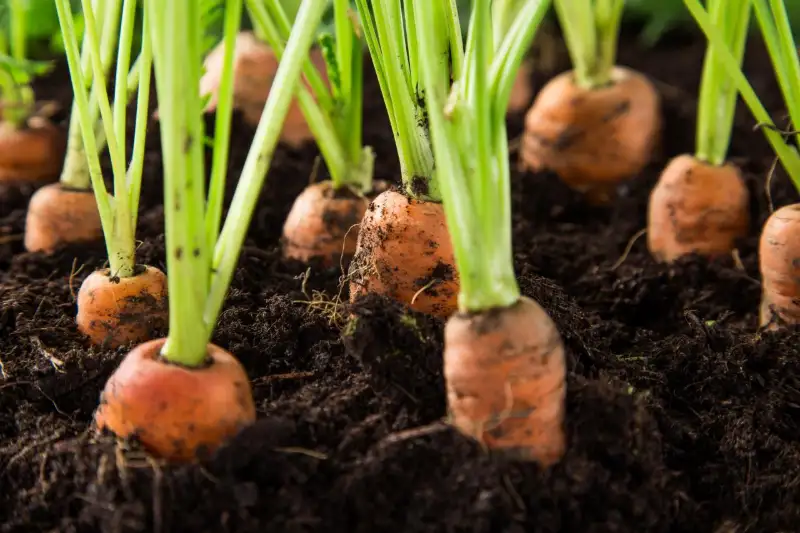
You get the best quality carrots by providing
- Better soil conditions
- Watering, and
- Care.
The other tips you need to follow before harvesting the carrots include:
- Initially, it would help if you waited until the carrots REACHED full maturity.
- Typically, carrots take about 2-3 months to mature, depending on the carrot varieties.
- Pro tip: The carrots are ready to yield when the top of the carrots gets the same diameter as that of the carrot itself.
- For EASY picking, you must APPLY water to the patch of carrots one day before harvest. Otherwise, you can use a garden fork to LOOSEN the soil-loose soil of your carrot bed and remove your carrots.
- Be gentle while handling the carrots to avoid bruising them.
- Use the carrots as soon as possible for the best flavor and texture. Alternatively, you can store them for a few weeks.
FAQs about When To Harvest Carrots
1. Can you leave carrots in the ground too long?
You can leave your carrots in the soil all winter LONG as the soil doesn’t freeze solid. Yes! You can ground freeze them.
But remember that you need to harvest them before EARLY spring.
Once spring arrives, it allows your carrots to flower and become INEDIBLE.
2. Is it a good idea to cut the tops off my carrots?
Straight simple, yes, you CAN!
The leaves of carrot root STEAL their nutrients, so you can cut the GREENS of the carrot to lock in nutrients.
3. Why shouldn’t you peel your carrots?
The carrot’s skin contains many nutrients, like fibers, vitamins, and minerals. Peeling the carrots REDUCES the skin, reducing the overall nutritional value.
The skin of the carrot also contributes to flavor and texture.
Peeling the carrot removes the outer layer and makes the carrot taste less flavorful.
4. Do I have to refrigerate after I harvest my carrots?
Yes! You have to store your homegrown carrots in a cool, dry place.
Store in damp sand in a root cellar or a basement for this purpose.
Try not to use the refrigerator, as carrots lose some FLAVOR and TEXTURE if stored in the fridge.
But if you don’t have something like that, you can store them in the refrigerator. Still, in this case, placing them in a perforated plastic bag is essential to keep them from drying out.
What’s Next
You have so many details, as only harvesting the carrots by looking at their greens is NOT enough.
It is necessary to learn how to harvest carrots on their
· Visual signs and
· Harvest for storage and
· Immediately use.
Moreover, the tips you have GAINED can be used to harvest and store too many carrots successfully.
That’s all for today. I hope this post helps you a lot.
If you really find this post helpful, don’t forget to share it with your friends.
You also read some other informative articles on our website.
